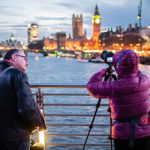
I want you to picture yourself and your family outside on a nice afternoon. It’s Thanksgiving, a great day for a family portrait. Unless it is a cloudy day, some nice shade will produce a flattering lighting ratio for your portrait. This means that the brightest part of the picture and the darkest part are not too far apart in value for the film or hard drive card to capture. Then choose a uniform background for you portrait. A stand of dark evergreens, a barn wall, a distant lawn, or a high hedge are all excellent backgrounds. The back of the house and patio, the driveway with the parked cars, or partially sunlit woods are too busy a background for your picture.
Next find something for people to sit on: a log, a small table from the patio, a picnic bench or a patio chair. The object is to have everyone’s head at a different level. Small children are, of course already low to the ground. Seat some people at chair height, others on the ground. Sitting like an Indian is not a viable pose. Try sitting the person down on the ground with their knees together, ankles crossed and to the side. Standing and leaning against something also provides a different height for your composition. Try to place the heads so that they do not line up either vertically or horizontally. Rather than presenting a square shoulder to the camera, a slight turn to the body is preferable. Eye glasses can be held in the hands or tilted down. Be creative in you grouping – two, threes and fours in a close grouping look better than one group of seventeen evenly spaced. Remember to overlap shoulders so that heads are closer together. One shoulder is all that is necessary to see.

A broad, low light source is ideal for a flattering look to your portrait. An open sky overhead will result in dark eye shadowing. Reflecting light into the shadow areas or using fill flash will correct this situation. Take advantage of the light from a white building or a setting sun. A natural solution is to place your group under some overhanging branches.
Center your grouping in the view finder, paying close attention to the edges of the finder. Leave a little space on the ends for cropping since the format of an eight by ten or sixteen by twenty photograph will crop ten percent off the ends. At the moment of exposure, do or say something to capture the attention of the whole group in order to coordinate the eyes in one direction. You can save a big paper smiley face until the last minute. The alternative is an interactive pose where everyone looks at each other, instead of the camera. This type of composition is more difficult, since facial profiles are less desirable. In order to insure open eyes, talk through the moment of exposure and for a good selection, take lots of pictures. Above all have fun and everyone will enjoy the experience. Happy shooting!
I did this for 30 years.
Like This Article?
Don't Miss The Next One!
Join over 100,000 photographers of all experience levels who receive our free photography tips and articles to stay current:






Leave a Reply